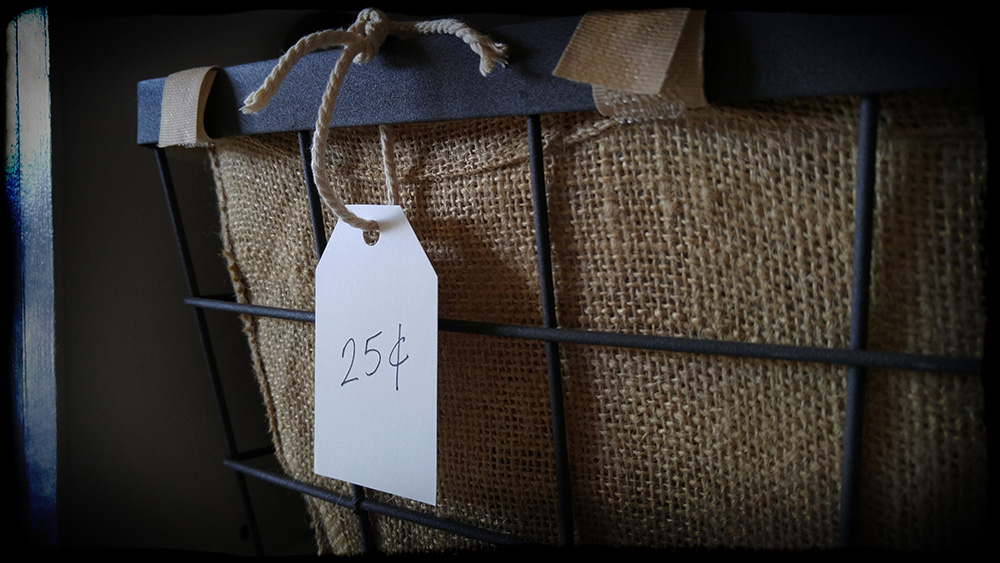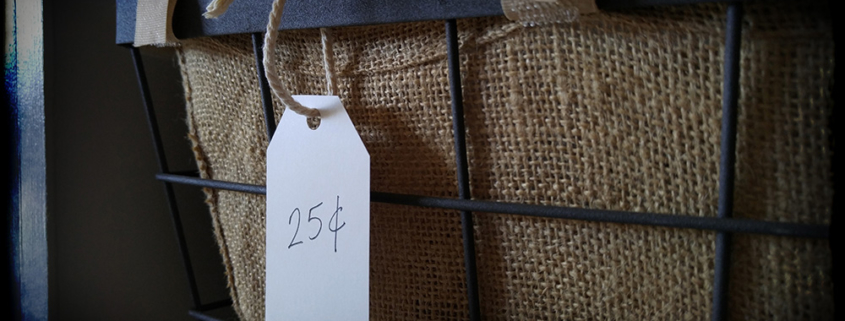The Beauty of Release

For two years and five months beginning in 2006, I lived in a 3000-square foot home—a sprawling suburban dream. It was a contemporary Spanish colonial with a red tiled roof and a series of sloping arches that surrounded the white stucco façade. My mother thought our house was the town library the first time she visited and saw it sitting atop the hill, grandly lit by recessed porch lights in our community-under-construction on a desert summer night in Arizona.
The kitchen was appointed with professional grade stainless steel appliances and a large island topped with a honed granite countertop that screamed, “I’m rare and precious.” The builders had hung hand-rubbed alder wood cabinets about two feet below the raised ceiling, creating a strange space that made the kitchen appear unfinished and empty. These same spaces had been filled with various decorative items in the designer-touched model homes. I watched HGTV and figured I was supposed to fill my newly acquired voids accordingly.
Each day, I’d leave my master-planned community after dropping my daughter off at the newly constructed elementary school, also stuccoed and arched, and head out to the malls that had sprouted up overnight in the middle of sprawling acreages of open farm land.
I wandered the isles of Ross, Home Goods, and Kirkland’s with the other zombie wives searching for the perfect items to place atop my kitchen cabinets. I had rules. The items I selected had to be tasteful. I wasn’t completely ready to sell my soul to suburbia and purchase anything with a rooster on it. And it had to be cheap. I mean final markdown cheap. I was okay with damaged items—a vase with a small crack or a dented metal sculpture would work just fine if I turned their imperfections to face the wall where no one would ever see them. I filled the space, one discounted item at a time, until my new kitchen resembled a somewhat classier version of Cracker Barrel or Chili’s.
 I arranged and rearranged items in our home each day, until it was time to pick up my daughter from school. Arriving ten minutes before the bell rang, I gave myself enough time to park the car and chat with a few of the other parents. Mostly we were women, financially fortunate enough to stay at home while our husbands went off to work each day earning enough income to support our shiny-suburban lives. Their jobs afforded us regular trips to Target, the grocery store, the dentist, and perhaps a summer trip to Disneyland or Legoland or Sea World.
I arranged and rearranged items in our home each day, until it was time to pick up my daughter from school. Arriving ten minutes before the bell rang, I gave myself enough time to park the car and chat with a few of the other parents. Mostly we were women, financially fortunate enough to stay at home while our husbands went off to work each day earning enough income to support our shiny-suburban lives. Their jobs afforded us regular trips to Target, the grocery store, the dentist, and perhaps a summer trip to Disneyland or Legoland or Sea World.
Then, on a crisp day in November, 2007 the Dow dropped 777 points. A seismic shift rippled throughout our tidy community. My shopping trips stopped and my daily chats with the other pick-up moms took on a tone of uncertainty. My stomach knotted every afternoon as I stepped onto the curb. I’d scan my neighbors’ faces for swollen eyes and runny noses—the tells that alerted us as to whose husband was laid off that day. It was like some sick version of suburban roulette. I’d tuck in my lips and nod at those mothers with red-rimmed eyes in acknowledgement of the fact that they had received the call. Their journey into the dark abyss was beginning and I imagined them bracing for the ride, seatbelts fastened snug around their hips, all loose items secured.
My daughter was still in elementary school and filled with the sweetness that allowed her to greet me each afternoon with arms outstretched and a sing-songy Mommmeee! I was so grateful for the distraction of her affection. Her small embrace and gooey kisses floated my sanity and prolonged my self-delusion for a few months. At least we were okay. My husband didn’t work for a large company that could lay him off. He was self-employed, working for the development and construction industries as an architectural illustrator, and could always find new clients.
Until he couldn’t.
The first few clients disappeared without much fanfare—a brief e-mail or a short phone call letting him know their project was being put on hold. Incomplete projects yielded zero payments. Zero payments yielded unpaid bills. We borrowed money from ourselves, convinced this was a temporary situation and we’d pay off our debt as soon as my husband landed a new project. This game went on for a few months. We received daily offers from our bank encouraging us to extend our credit line. We’ll be fine, we thought. The bank is still betting on us.
Until they didn’t.
In a Hail Mary attempt, we reached out to our parents, asking for a large loan to help us correct our deficits. With heavy hearts, they denied our requests, offering well-intended advice rather than handing over their own retirement savings. I signed up to work as a substitute teacher at my daughter’s school. At first the calls came in every day, and then slowly trickled to one assignment a week as the sub roster filled up with my neighbors’ names.
* * *
When Obama took office, his administration advised us to contact the HOPE hotline to request a modification loan. A kind young man on the other end of the call encouraged us to immediately stop making mortgage payments. He said the HOPE program could only help us if we were behind on our payments for three or more months. His advice felt scary and wrong and against everything we’d ever been taught about homeownership. We were flailing. We complied.
Foreclosure notices began arriving immediately. We’d call the HOPE office every few days for reassurance that we were doing the right thing and that they were going to intervene and help us save our home. Each call would connect me with another new, inexperienced voice. They’d ask us to send pages and pages of documents: three months’ worth of bank statements, two years of prior taxes, budgets, business profit and loss statements. I handled the gathering and sending as my husband scrounged for any type of work he could milk from his remaining clients. I’d always follow up with our latest HOPE negotiator’s requests, only to be told they’d never received my paperwork and could I please go ahead and send it all through again?
HOPE was disorganized. Our finances were disorganized. Our community was disorganized. Our dream, our collective dream crumbled as we looked on from the steps of our stuccoed Spanish contemporary.
In the early spring of 2009, I laid out all of my cabinet swag—bread baskets and decorative plates and pitchers and vases and oversized letters spelling “EAT”— on borrowed card tables inside our garage and waited as eager neighbors combed through them hoping to take advantage of my misfortune and good taste. I accepted all offers and refused to barter with anyone. Extended family arrived to help out. And I was scolded for not haggling. According to their garage sale expertise, I was letting my money “walk away.”
Explaining my methods of release and acceptance felt futile. I wasn’t letting opportunity escape, I was exercising the one last sliver of control I had in my life. I was letting go of the crap that had consumed me, that I’d attempted to fill my voids with. I was finding beauty in the release of my possessions—my discount wares, my house, my utopian community, my American Dream.
It was during my first downsizing garage sale that the foreclosure processor showed up. She taped a public notice to the front door with a piece of beige masking tape, and then shrugged and apologized. We told her we understood and she asked if she could shop our sale. The irony cut through me like a hot knife and I stifled my pain with humor. I can’t remember exactly what I said, but it diffused the awkwardness of the situation and she laughed, handed me some coins, and walked away with a dented metal vase.
The grief of losing a house feels a lot like the grief of losing a person. I stepped through the stages in a completely irrational and non-linear way. Some days I was grounded in acceptance, trolling Craigslist for free moving boxes, while other days found me raging against the inevitable, refusing to remove family pictures from the hallway. I felt pain and sadness and remarkable amounts of shame. I learned to let go of the way-things-should-have-been narrative running on a constant loop in my brain. My desire to look back and judge our decisions, trying like hell to determine the moment it all went so wrong, began to fade as I released the dream and tried to move on in search of a new normal; wherever and whatever it may be.
We packed up our car and left the suburbs on a sweltering summer day in 2009. We returned to the city and moved into a rental we affectionately deemed our “penalty box.” Today, I stand in our imperfect present, eyes wide open, and say with all certainty that I am grateful for our loss. I like this version of myself, my family, better than the one that bought into the dream in 2006. We are humbled. Our priorities have shifted. We aren’t as afraid as we once were. We appreciate our family, friends, acquaintances and each other more. We no longer feel the need to run from uncertainty, because we know it is a given, not just for us, but for anyone daring enough to live. The mere act of existing is rife with risk. None of us will escape this planet without the scars of trial and loss.
* * *
In 2010, The Dodd-Frank Wall Street Reform and Consumer Protection Act, a federal law designed to prevent banks and financial institutions from taking on too much risk, was established after millions of Americans lost their homes to foreclosure. Because of the protections put in place, many of those same Americans have been able to rebuild their lives and re-enter the housing market—including my own family.
I’ve lived long enough now to have survived many life shifts—the ones that force you into a new normal, willingly, or not. I’ve been present for official cancer diagnoses, divorce announcements, career endings, car repossessions and bankruptcy hearings, moments of inevitable change—points of no return. The permanent markers of life before and after. They are never remarkable occasions in the moment. Instead, they’re rather plain and ordinary. Their weight is only realized and appreciated down the road after healthy distance is established and the lessons behind the shift can be understood and valued.
Donald Trump has been inaugurated as the forty-fifth president of the United States, and as a nation we are officially thrust into our new normal. Uncertainty surrounding his administration’s proposed changes to health care, immigration, education, women’s issues, climate protection, foreign policy and press access infiltrate our day-to-day existence. Everything previously designed to protect the best interest of our citizens is up for discussion, reorganization, and possible dismantling. Our new president values excess and things. He doesn’t need the protection Dodd-Frank offers. His wife and child live in a tower of gold.
What we’ve known and come to expect from our country shifts. Our foundation is rocked. We waver between feelings of anger and fear and helplessness. Some days we cry, and some days we rage. I wish for us all a quiet moment amidst the social media feeds and endless news cycles where we might pause, look inward, and ask, “Who do I want to be when I make it through to the other side?” Because this too shall pass; I promise. I know. No doubt the next four years will take us down to depths we didn’t even know existed, but we will find our way out again. And what’s left after the shift will be stronger and sweeter because it will be hard-earned and it will be real.
After a twenty-five-year hiatus, I made the decision to return to college in 2015. I wanted to learn more about writing, and about myself. Studying creative writing forces you to examine personal truths. Surviving the past decade has revealed mine. I need my heart, my brain and my family to survive this world. Everything else is a fickle bonus.
This afternoon, I’ll resume working on manuscript revisions needed to complete my MFA. I’m focusing on my story’s climax today. I will release precious words, clever dialogue and superfluous characters before my daily practice is complete. It will be hard, but I do this knowing that my story will be truer and cleaner and more honest in the end. Then I’ll venture into my tiny kitchen, open the pantry and select some loose tea leaves. I’ll settle on a nice green with hints of orange that I picked up during my last residency in Los Angeles. While I wait for my tea to steep, I’ll admire my current lack of kitchen décor. And for a moment, I will feel grounded in simplicity while the promises of gilded dreams lurk beyond my back door.
 Kim Sabin studies Young Adult in the MFA program at Antioch University Los Angeles. When she isn’t driving across the desert to study craft, she lives in Scottsdale, Arizona with her husband and daughter.
Kim Sabin studies Young Adult in the MFA program at Antioch University Los Angeles. When she isn’t driving across the desert to study craft, she lives in Scottsdale, Arizona with her husband and daughter.





